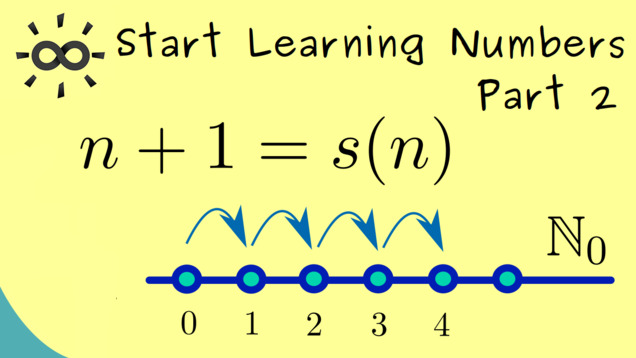
-
Title: Natural Numbers (Successor Map and Addition)
-
Series: Start Learning Numbers
-
Parent Series: Start Learning Mathematics
-
YouTube-Title: Start Learning Numbers 2 | Natural Numbers (Successor Map and Addition)
-
Bright video: https://youtu.be/C9DLEHu1l-g
-
Dark video: https://youtu.be/1F5nAc4qe68
-
Ad-free video: Watch Vimeo video
-
Quiz: Test your knowledge
-
Dark-PDF: Download PDF version of the dark video
-
Print-PDF: Download printable PDF version
-
Thumbnail (bright): Download PNG
-
Thumbnail (dark): Download PNG
-
Subtitle on GitHub: sln02_sub_eng.srt missing
-
Timestamps (n/a)
-
Subtitle in English (n/a)
-
Quiz Content
Q1: The natural numbers have the important successor map $s: \mathbb{N}_0 \rightarrow \mathbb{N}_0$. What is not a property of $s$?
A1: $s$ is surjective.
A2: $s$ is injective.
A3: If $M \subseteq \mathbb{N}_0$ such that $0 \in M$ and $s[M] \subseteq M$, then $M = \mathbb{N}_0$.
Q2: How is the addition $m+1$ defined?
A1: $m+1 = s(m)$
A2: $m+ 1 = s(m+1)$
A3: $m = s(m+1)$
Q3: Dedekind’s recursion principle is a fact we can use a lot in these foundations. What is the correct formulation for this when we have a set $A$, a map $h: A \rightarrow A$ and a point $a \in A$?
A1: There is a unique map $f: \mathbb{N}_0 \rightarrow A$ with $f(0) = a$ and $f(n+1) = h(f(n))$.
A2: There is a unique map $f: \mathbb{N}_0 \rightarrow \mathbb{N}_0$ with $f(0) = a$ and $f(n+1) = h(f(n))$.
A3: There is a unique map $f: \mathbb{N}_0 \rightarrow \mathbb{N}_0$ with $f(0) = 0$ and $f(1) = h(f(n))$.
-
Last update: 2024-10